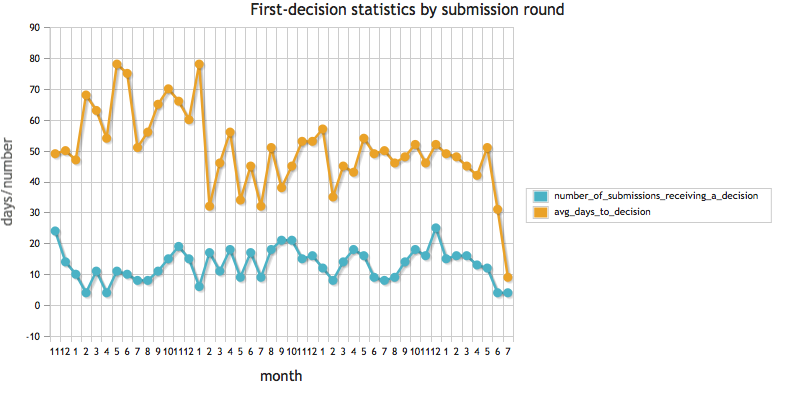Difference between revisions of "2016Q3 Reports: TACL Journal Editor"
LillianLee (talk | contribs) m |
LillianLee (talk | contribs) m |
||
| Line 4: | Line 4: | ||
== Some statistics == | == Some statistics == | ||
| + | === number of submissions and timing of first decision === | ||
Depicted below is the history of the number of distinct submission IDs that have received a decision, and the average time to first decision, grouped by round (=nearest first-of-the-month). | Depicted below is the history of the number of distinct submission IDs that have received a decision, and the average time to first decision, grouped by round (=nearest first-of-the-month). | ||
| Line 9: | Line 10: | ||
The drop in the last two months is due at least in part to 13 papers submitted in that period that have not yet received a decision. Also, not counted: papers handled using START (the early days of TACL), papers, papers archived for some technical or formatting problem. The decision time for papers submitted late in a month is counted as starting from the first of the next month. | The drop in the last two months is due at least in part to 13 papers submitted in that period that have not yet received a decision. Also, not counted: papers handled using START (the early days of TACL), papers, papers archived for some technical or formatting problem. The decision time for papers submitted late in a month is counted as starting from the first of the next month. | ||
| + | |||
| + | |||
| + | |||
| + | ''Observations'': | ||
| + | |||
| + | While we don't count technical/format problems, we "do" count papers that receive an editorial decision of rejection without going out for full review. One way we EiCs trying to keep reviewing loads down and keep submissions interesting for our reviewers is sometimes doing a preliminary consultation with an action editor or highly relevant reviewer for submissions that seem highly unlikely to be accepted. Such consultations and subsequent discussion can take two weeks or so, since we strive to be cautious about making such decisions, but also want to factor in the value of conserving reviewer effort. | ||
| + | |||
| + | Waves in the number of submissions seem correlated with upcoming conference deadlines. | ||
| + | |||
| + | Average decision times per month appear to correspond well with an ideal but attainable schedule of | ||
| + | |||
| + | * ideally 7 days to make a load-balanced assignment of submission to action editors (AEs) | ||
| + | * ideally 7 days for AEs to get three reviewers confirmed to review | ||
| + | * ideally 21 days for reviewers to review | ||
| + | * ideally 10 days for AE to coordinate discussion among reviewers and come to a decision | ||
| + | which would yield an ideal target of 45 days turnaround. | ||
| + | |||
| + | === Decision statistics === | ||
Revision as of 00:15, 22 July 2016
(We are grateful to have received an extension on filing our report until July 22 from ACL Secretary Shiqi Zhao. --the TACL editors in chief)
Some statistics
number of submissions and timing of first decision
Depicted below is the history of the number of distinct submission IDs that have received a decision, and the average time to first decision, grouped by round (=nearest first-of-the-month).
The drop in the last two months is due at least in part to 13 papers submitted in that period that have not yet received a decision. Also, not counted: papers handled using START (the early days of TACL), papers, papers archived for some technical or formatting problem. The decision time for papers submitted late in a month is counted as starting from the first of the next month.
Observations:
While we don't count technical/format problems, we "do" count papers that receive an editorial decision of rejection without going out for full review. One way we EiCs trying to keep reviewing loads down and keep submissions interesting for our reviewers is sometimes doing a preliminary consultation with an action editor or highly relevant reviewer for submissions that seem highly unlikely to be accepted. Such consultations and subsequent discussion can take two weeks or so, since we strive to be cautious about making such decisions, but also want to factor in the value of conserving reviewer effort.
Waves in the number of submissions seem correlated with upcoming conference deadlines.
Average decision times per month appear to correspond well with an ideal but attainable schedule of
- ideally 7 days to make a load-balanced assignment of submission to action editors (AEs)
- ideally 7 days for AEs to get three reviewers confirmed to review
- ideally 21 days for reviewers to review
- ideally 10 days for AE to coordinate discussion among reviewers and come to a decision
which would yield an ideal target of 45 days turnaround.
